
The second international trip Mike and I took together was to Belize for our PADI open-water diver certification. In many ways, the vacation was a test to see, not only if we loved scuba, but also traveling together. After days of exploring the tropical waters, swimming alongside eagle rays, nurse sharks, countless reef fish, and my adorable boyfriend, the answer was a resounding yes and yes! We quickly realized diving was an incredible and integral way to explore this blue planet, and we’ve since done 200+ dives across the continents! Looking back on our 18 years as scuba divers, we’re excited to share our top 10 dive destinations in the world.
Roatán, Honduras: Shore Dives & Caverns
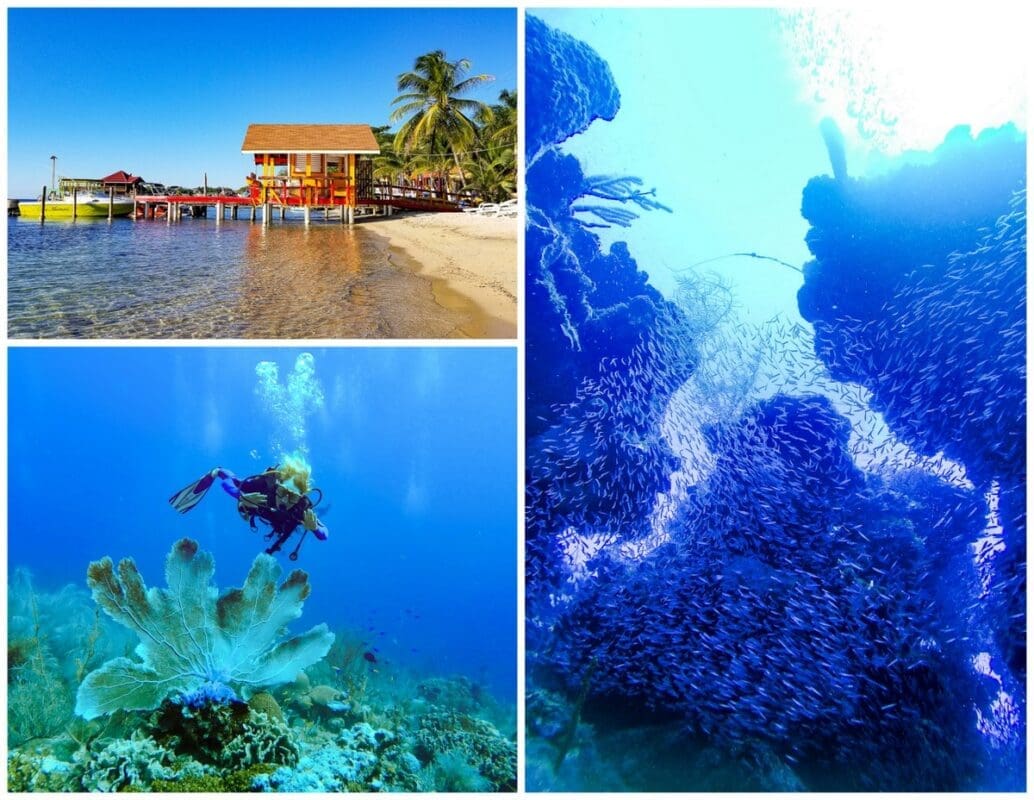
When we told people we were housesitting for two months in Honduras, most thought we were nuts, but our diver friends completely understood. In a prime stretch of the Mesoamerican Barrier Reef (the second largest in the world), Roatán is among the best Caribbean diving destinations, with 500+ species of fish, dozens of shipwrecks, sea walls, underwater caves, and boundless coral gardens. The section between West End and West Bay is the island’s scuba diving hub, with many of the sites accessible right from shore or a few-minute boat ride for super easy access.
Tabyana
We went on three incredible dive trips, starting in West Bay’s Tabyana. First and foremost, this site is an incredible rock formation with crags letting in light for vibrant corals, nooks for a wide range of habitats, and passageways to delight the explorer in all of us. We dove a dramatic coral swim-through and were surrounded by thousands of silverside fish. Ascending from the chasm, we were in gardens of purple fan coral and parrot fish cleaning the reef, for a dive that made us want to become Cavern-Diver Certified.
Roatán Banks

Cayos Cochinos is within the UNESCO heritage section of the Mesoamerican Barrier Reef, but savvy scuba outfitters know the best diving is just before Cayos in the deep seamount of the Roatán Banks. We dropped down 40 feet and there seemed to be every type of coral and reef fish imaginable. Peering into azure barrel sponges, eyeing up green morays and channel-clinging crabs in the crevices, examining the peculiar nudibranch, and having a reef shark whiz by us was a delight! Any scuba driver will tell you that our oceans are warming and coral bleaching is happening worldwide, but when you come to a place like The Banks it gives you hope it’s not too late. For more on protecting this reef, check out the great work by the non-profit and ocean watchdog, Roatán Marine Park.
More Roatán Top Dive Destinations & Adventures
Dive Cayos Cochinos, Mary’s Place, Hole in the Wall, West End Wall, and El Aguila Shipwreck. For more Roatán adventures, don’t miss the story of our wild bungalow-housesit.
Greater Sipadan, Malaysia: Drifts & Macro

The Coral Triangle is the most biodiverse marine region in the world with over 6,000 species of fish and 76% of the planet’s coral species. It’s lined with epic scuba diving destinations, but one that consistently tops the lists? Sipadan, Malaysia. The varied terrain in Malaysia’s Celebes Sea offered us every kind of dive, from high-speed drift to shipwreck to otherworldly macro. Bumphead parrotfish, whitetip reef sharks, spotted rays, green sea turtles, countless reef fish, and nudibranchs galore graced our 11 dives. And to make this trip even more memorable, we stayed on a liveaboard like no other, Seaventures Dive Rig…a 1970s oil rig turned eco-friendly dive resort hovering over the reef. The old cargo deck has been turned into a PADI dive center and restaurant, employee housing into suites, the helipad into a sweeping rooftop patio, and the freight elevator into a fun way to reach the sea. Our days were filled with three scuba sessions (plus as many as we’d like at the house reef directly below the rig), with breaks for bountiful meals, roof deck lounging, high dives off the plank, and boat trips to the fascinating Bajau Laut (aka “sea gypsy”) village on Mabul Island.
Sipadan Marine Park
Rising 2,000 feet above the sea floor and covered in 100 species of coral, this is the oceanic island that draws people to the region. Due to its popularity, you’ll need a park permit and Advanced Open-Water Certification, with a max of two dives per day at Sipadan’s 13 sites. Barracuda Point is the channel where these toothy beasts love to congregate, and West Ridge is where the bumphead parrotfish like to bask in the dawn light.
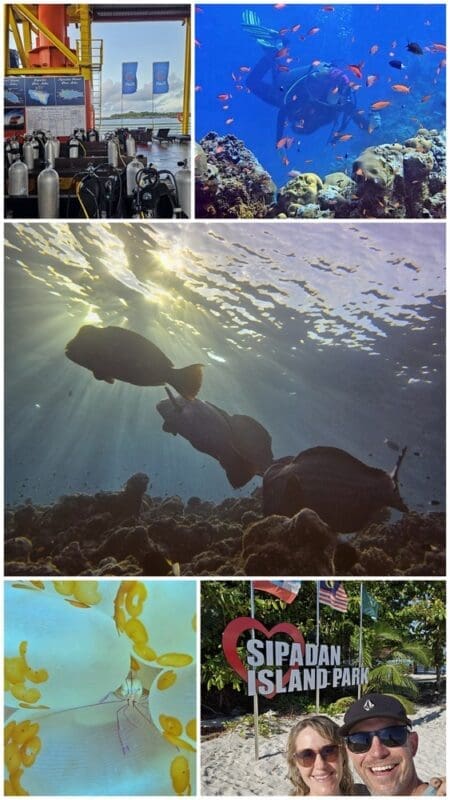
Paradise 1 & Paradise 2
While the beige sandy bottom and artificial reef of north Mabul Island might not seem like much at first, here lies some of the Coral Triangle’s finest macro and muck diving. Scouring the sea floor we found a plethora of colorful nudibranchs, cuttlefish, frogfish (Mike’s new favorite creature), and more weird and wonderful marine life. Plus, we saw a school of ~800 jackfish!
West Mabul
The west side of Mabul has a stunning wall with enough current for a thrilling drift dive. Starting at Lobster Wall, it turned into a turbo drift to Panglima Reef, where we were greeted by an abundance of tropical fish and multiple green sea turtles.
More Borneo Top Dive Destinations & Adventures
Dive Mataking, Mandarin Valley, Hanging Reef, and The Dropoff. Discover more adventures around Borneo, Malaysia in our new guide.
Galapagos, Ecuador: Endemic Species & Sheer Abundance

Exploring the Galapagos Islands is like a safari at sea. But unlike an elusive cheetah or lioness in the tall grasses of the savanna, the Galapagos wildlife doesn’t shy away…they are equally curious about you. Playful sea lions swim up to snorkelers, penguins do laps around kayakers, and iguanas sunbathe alongside you. Isolated 1,000 kilometers off the coast of Ecuador, these volcanic islands’ endemic species served as the groundwork for Charles Darwin’s Theory of Evolution and remain one of the world’s premier wildlife-viewing destinations.
To explore this National Park and UNESCO Heritage Site, we went with Active Adventures and made sure scuba diving was a part of our package. Not only is this area of the East Pacific teeming with awe-inspiring sharks, rays, sea lions, and turtles, but over 2,900 other marine organisms discovered in the Galapagos.
Kicker Rock
Shaped like a boot split in two, this underwater volcano off San Cristóbal Island is nothing short of incredible. The canyon through the middle is a veritable fish highway and we took a ride in the fast lane. Marine life of countless varieties — hammerhead sharks, scorpion fish, Pacific green sea turtles, whitetip sharks, and sea lions all gave us close encounters. Words cannot fully describe the volume and beauty of marine life we saw on our two dives at Kicker Rock. Watch for yourselves (above).
Darwin & Wolf Islands
These neighboring islands on the northwest side of the archipelago always top the list of the Galapagos best dive sites. Due to their remote location, these isles and their dozen sites are most commonly accessed by liveaboard ships, but once you’re there, you’ll have diving for days. We’ll certainly be adding it to our next trip!
More Galapagos Top Dive Destinations & Adventures
Dive El Arco, Gordon Rocks, North Seymour Ocean Side, and Cape Marshall. For more things to do in the Galapagos, check out our two-part island-hopping guide.
Timor-Leste: Coral Garden of Eden + Whales

Mark our words, Timor-Leste is the new frontier in scuba diving. Hidden away as a Portuguese colony for over 400 years, followed by Indonesian military occupation for the next two decades, and propped up by UN Peacekeeping operations until 2012, Timor-Leste never really had the chance to develop and its reef is pristine as a result. Along the Ombai Strait and Indonesian Throughflow, where upwelling from the deep basins of the Banda Sea brings nutrient-rich water, the area is a paradise for marine mammals and reef fish alike. It’s a major migratory route for whales, including blue, beaked, humpback, sperm, killer, melonhead, plus super pods of dolphins. October-December is the best time to whale watch and, better yet, swim with the blue whales–one of the few places on Earth where this is even possible! Then there is Ataúro Island, which Conservation International found the highest average reef fish diversity in the world (a whopping 642 species), and according to us, the prettiest coral gardens we’ve ever seen!
Ataúro Island & Two-Mile Reef
We set out for Ataúro with the seasoned Aquatica Dive Resort, one of the island’s longest-running operators, and were quickly surrounded by a dozen pilot whales and over 100 dolphins. As Ataúro’s sheer cliffs drew closer, we hugged the west side of their stunning shoreline and dropped in at Iliana. The Two-Mile Reef combines the villages of Iliana and Arlo, with incredible walls of soft coral colonies and huge sponges. The color, textures, and density of life on the wall were like nothing we’ve seen in our 18 years of diving. We saw snappers, surgeonfish, fusiliers, trevally, and so many schools of blue tangs it could have been a university. While you can often see eagle rays, dogtooth tuna, and barracudas, it wasn’t about the big fish, it was the sheer abundance of life in all its forms and a new standard for healthy reefs on this planet!
Ombai Strait

Swimming with the largest mammal on earth is not usually on the dive menu, but Desmond Lee, owner of Aquatica Dive Resort was convinced he could offer it up (in a safe and respectful manner) during the blue whale migration each fall. Studying their patterns as they move through the Ombai Strait, he’s found a way for free divers to join the whales at the right moment for eye-to-eye observation. We will certainly be back for this!
More Timor-Leste Dive Destinations & Adventures
Dive Arlo Amphitheater, Bubble Beach, Clownfish City, and Jaco Island. See more of our Timor-Leste adventures in this Instagram Reel.
Fakarava Atoll, French Polynesia: Shark Gauntlet

French Polynesia is a country made up of over 100 islands and atolls, with Fakarava bringing out the best of its biodiversity. A UNESCO Biosphere Reserve in the Tuamotu Archipelago, Fakarava boasts the second-biggest lagoon in French Polynesia. With two passes on the opposite sides of the atoll, plankton and schools of fish are funneled between the natural gates, attracting droves of pelagics. Famous for its “wall of sharks” and excellent visibility (up to 100 feet!), it’s a bucket-list diving destination made better with dreamy turquoise water and white sand spits. This part of the Pacific also holds an extra big spot in our hearts because it’s also where we learned to sail. Over eight days, we had the chance to explore the atoll by yacht and dive it from end to end.
Garuae Pass
Starting in the north of the atoll, we dove Garuae, French Polynesia’s widest pass (more than a mile!). The varied topography allows for shallow dives among the hard corals and a fun drift into the heart of the channel. The high density of fish includes jacks, perches, goatfish, groupers, and wrasses, along with plenty of predators from sleeper sharks to moray eels.
Tetamanu Pass
After days of sailing, anchoring at secluded coves, SUPing to shore for coconuts and hearts of palm, and living our best pirate life, we reached Tetamanu Pass in the far south. It brings a strong incoming current and so many resting sharks it’s been dubbed ‘the wall of sharks.” While our timing wasn’t right for the true “wall,” we had so much fun riding the current with the fishies and ending our drift dive with a dramatic finale of gray reef sharks on a tag-team, high-speed chase to catch and thrash their dinner.
More French Polynesia Top Dive Destinations and Adventures
Dive Tumakohua Pass, North Pass, and neighboring atoll Rangiroa’s Passe de Tiputa. Check out more of our sailing and scuba adventures around French Polynesia.
Calamian Islands, Philippines: Wreck Diving Sample Platter

Unroll your map of the Philippines’ 7,107 tropical islands, hone in on the archipelagos splitting the Sulu and South China Seas…and you’ll find the Calamianes. This island grouping around northern Palawan is absolutely stunning with its black limestone mountains, turquoise lakes, and beaches. When it comes to wreck diving, Coron Island is arguably the best place in the world to give it a try. Most wreck dives require a special PADI certification, due to deeper depths and dangers of entering enclosed and unstable structures, but Coron’s unique history brings them within reach. Toward the end of World War II, the US Navy pinpointed Coron Bay as a safe haven for Japanese supply boats and battleships. At 9am on September 24th, 1944 a surprise air strike sunk 24 ships in one hour, leaving behind a wide variety of structures for divers at every level to explore.
Sangat Island
We went to Sangat Island which has Coron Bay’s largest concentration of sunken ships, with 11 being within recreational dive depths of 9 to 140 feet. Wreck diving can be a little scary, so East Tangat, a gunboat/anti-submarine craft that lies on a shallow slope, lets you evaluate the relic in the bright sunlight and work your way down. Both soft and hard corals have made it their home and schools of angelfish and butterflyfish move through the storied spaces.
Olympia Maru
A 425-foot-long mobile aircraft repair facility and supply depot for the Japanese Army now lies at the base of Busuanga Island. The main deck sits at 59-79 feet deep and with a wide-open cargo area, it’s easier to explore and examine this piece of history. Moving through the wheelhouse and propeller shaft, we felt like we were in a Discovery Channel special! The structure and context of World War II combat were fascinating in and of itself, then add in the marine life, including adorable puffers and a school of jackfish, and our minds were blown.

More Palawan Top Dive Destinations & Adventures
Dive Irako, Akitsushima Warship, and Dimakya Island, and explore more of the Philippines.
Cayman Islands: Wall, Wreck, Shore
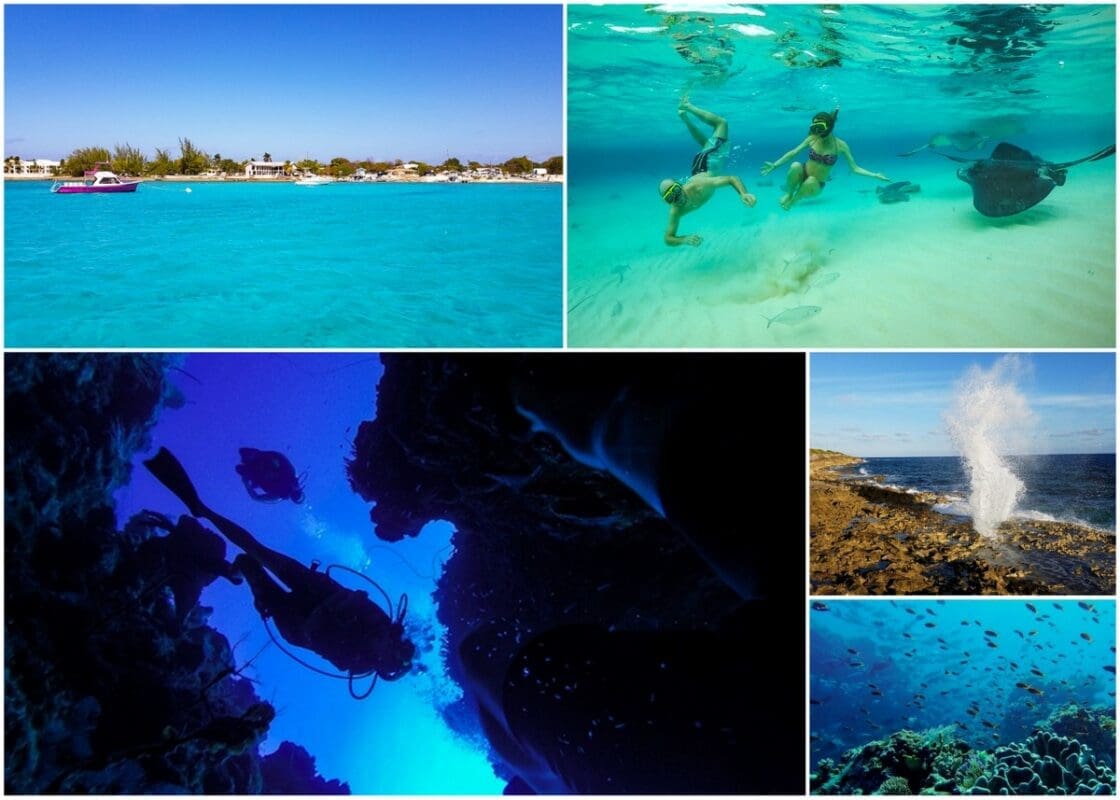
The Caribbean’s Cayman Islands may not be known for their mountains above the sea, but below, the walls rise 6,000 feet for some epic diving. And if that kind of drop makes you weak in the knees, Grand Cayman also has some of the best shore dives around with amazing rock formations and shipwrecks that even beginners can enjoy. With 365 dive sites, this three-island nation takes diving and ocean conservation seriously, offering some of the best Caribbean diving for every day of the year.
Trinity Caves, West Bay
Five minutes from shore, across the teal shallows of the westside, the sea floor seemed to drop out from under us. It was a shade of blue reserved for deep-sea fishing trips and trans-Atlantic voyages. Kitted out like Jacques Cousteau, we descended a hundred feet to the Trinity Caves. Passing dragon whips and sea fans, we entered the craggy rock tunnel with beams of light peeking through. The Trinity reference is for the three caves, but also the look of a rough-hewn cathedral. We met a spotted eagle ray, parrot fish, clinging crabs, a Nassau grouper with a belly full of eggs, and more beguiling creatures.
Doc Poulson Wreck

This old telecommunications cable boat has been lying on the sea floor since the 1980s and found a second life as a coral garden. We swam into the hull, moving through mangled iron with schools of fish, emerged through the floorboards, and took the helm in the wheelhouse feeling like proper underwater explorers.
More Cayman Islands Top Dive Destinations & Adventures
Dive Ironshore Gardens, Lighthouse Point Reef, USS Kittiwake, Bloody Bay Marine Park, and Captain Keith Tibbetts. Read our Cayman Islands getaway guide for more Caribbean fun.
Koh Phi Phi, Thailand: Colorful Corals & Caverns

Leonardo DiCaprio’s The Beach made everyone want to check out Koh Phi Phi Island’s azure water and white sand utopia…especially if you were already in the Andaman Sea neighborhood. We too joined the ranks of meatheads and misfits attracted to Southern Thailand, with visions of Leo dancing through our heads, and experienced it for ourselves. We got there and, although Koh Phi Phi was indeed party madness, its limestone islands and coral gardens were even better than movies.
Koh Bida Nok
This island across the way slopes down to an incredibly vibrant reef, teeming with marine life. The underwater topography ranges from sandy bottoms, steep walls, small caves, large crevices, and rolling reefs. It’s covered in a wide range of soft and hard corals, for some of the best colors left in the sea. Big schools of tuna, trevallies, two-spot snappers, anemone fish, butterflyfish, and even the rare Ghost Pipe can be seen here, plus, we spotted over a dozen Hawksbill turtles! Come May-August, you may even see whale sharks passing through, and blacktip reef sharks and leopard sharks can be spotted most of the year.
Koh Phi Phi Le & Maya Bay
This is home of the actual Beach beach. The north side of the bay has a sloping reef, some dramatic rock formations, including an awesome swim-through, a steep wall, and one of the largest caverns in the area. The best part was, by the time we were done with our dives, the tour boats had gone home and we had the cove to ourselves for sunset and a swim to our own mini Beach tucked in the cliffs.
More Thailand Top Dive Destinations & Adventures
Dive Hin Dot, Hin Daeng, Hin Muang, and Anemone Reef. Having spent five weeks in Thailand, we have lots more travel tips to share.
Great Barrier Reef, Australia: The Mother of Them All
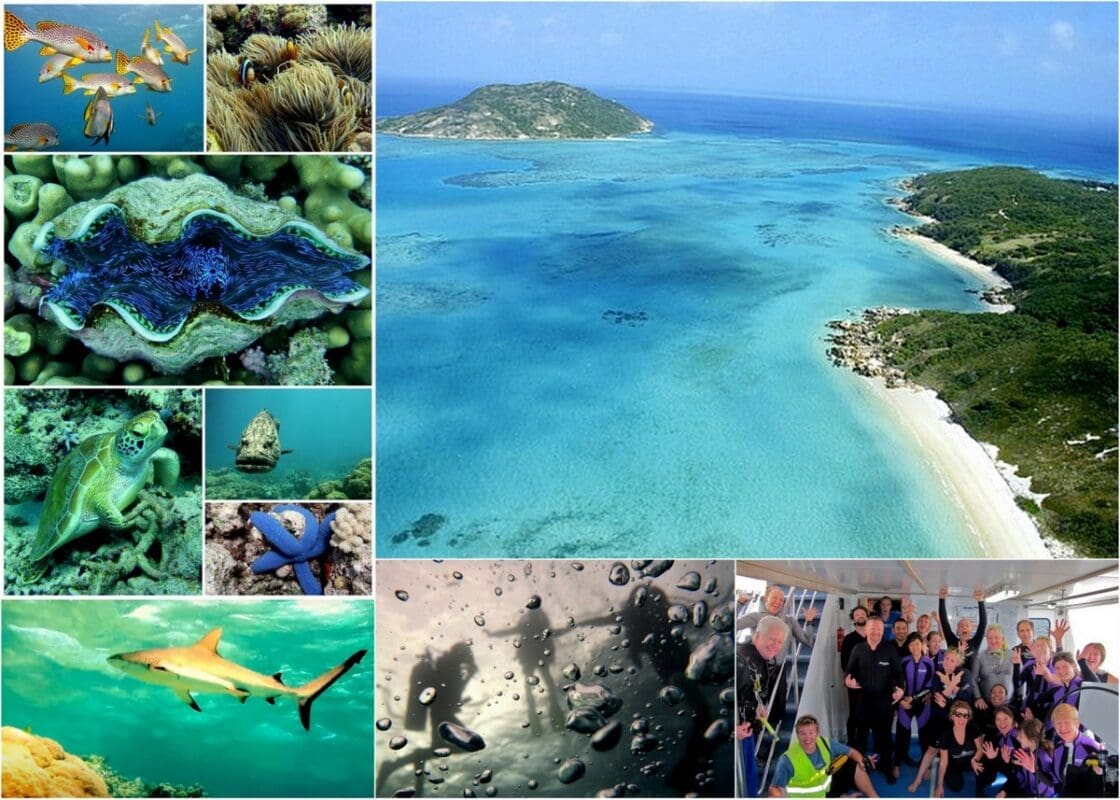
This list wouldn’t be complete without the Great Barrier Reef….the largest living structure on this planet! Teeming with 600 types of corals, 1,625 species of fish, 3,000 varieties of mollusks, and a quantity of sharks I don’t even want to comprehend, it is truly a world wonder. But don’t think you can just book a two-tank dive from the gateway city of Cairns and get the gist. We joined the Spirit of Freedom’s three-day Cod Hole and Ribbons Reef Dive Adventure in the remote northern sector of the protected park, and got Advanced Open Water Certified along the way to go even deeper…so worth it!
Dynamite Pass & Pixie Pinnacle
Diving three times a day, plus occasional night dives, we encountered hundreds of types of fish, including spotted stingray, hawksbill turtles, whitetip reef sharks, sea snakes, giant clams, diagonal banded sweetlips, puffer fish, giant trevally, Maori Wrasse, and barracuda from Dynamite Pass to Pixie Pinnacle.
Cod Hole
The liveaboard gave us access to so many incredible lesser-known dive sites…but when in the GBR, you have to see the world-famous Cod Hole. A family of potato cod likes to hang out at Ribbon Reef #10 and swim up to scuba divers, especially when park-sanctioned fish food is on hand. This area is highly regulated but a small number of divers are allowed to feed the cod each day. At the bottom of the sea floor, we sat in a circle while 200-pound fish (that can reach 6 feet in length) swam in front of our faces, pursing their voluptuous lips.
The gorgeous Lizard Island was the perfect Great Barrier Reef finale and better yet, we came away with friends that we are still in touch with 10 years later!
More Great Barrier Reef Top Dive Destinations
Eddy Reef, Lighthouse Bommies, Museum of Underwater Art, and the Whitsundays (a whole world we’re dying to dive into!)
Komodo National Park, Indonesia: Best Dive Destination Overall!

The cool currents of the Indian Ocean collide with the warm waters of the Pacific, creating the perfect storm for a profusion of marine life in the waters of Indonesia’s Komodo National Park & UNESCO World Heritage Site. This marine area was originally created to protect the only habitat of the world’s largest lizard, but they found the ecosystem below the islands to be just as important. In the heart of the Coral Triangle, Komodo’s 29 islands and countless reefs are at the pinnacle of its biodiversity. The nutrient-rich currents bring over 1,000 species of fish and 250 species of coral…and that’s just below the surface. Jagged mountains, pink sand beaches, and the only habitat for the Komodo dragon are waiting in the islands above. Our four-day liveaboard here was absolutely incredible, so much so that we featured it in our National Geographic Book, Ultimate Journeys for Two.
Manta Point
We descended into Makassar Reef, where the biiiiig rays come to play and snack on plankton. Hanging out for fifteen minutes along the rocky bottom, we started to doubt its reputation as “Manta Point,” then seemingly on queue this beauty, with a 10-foot wingspan, and a few friends gracefully flew past us. Aside from the mantas, the shallow reef is in good shape with giant trevallies, huge clams, various sponges, and cuttlefish, along with the occasional eagle rays, sharks, and turtles.
The Cauldron
Three days of thrills culminated at The Cauldron, a place with such a strong current that you can literally see it bubbling from the surface. It began with an unassuming drift dive over a coral garden, complete with gorgonian fans and coral bommies, then the current began to pick up as the floor went from 75 to 45 feet and the walls closed in. Soon we were speeding through a narrow canyon along a fish superhighway. Looking through the swirling water and past the tuna traffic, we spotted our guide signaling to huddle up and hang on! We secured ourselves with a reef hook (the only way to stay in one place) and let the marine life—schools of midnight snapper, giant trevally, even a few sharks—whiz by. After 10 minutes, we pulled our hook and rode “The Shotgun” until the currents dissipated and our hearts stopped racing. Slightly terrifying, utterly amazing.
More Komodo Top Dive Destinations & Adventures
Dive Batu Bolong, The Passage, and Crystal Rock, and learn about our full Komodo Liveaboard experience, here.
Make Diving a Part of Your World
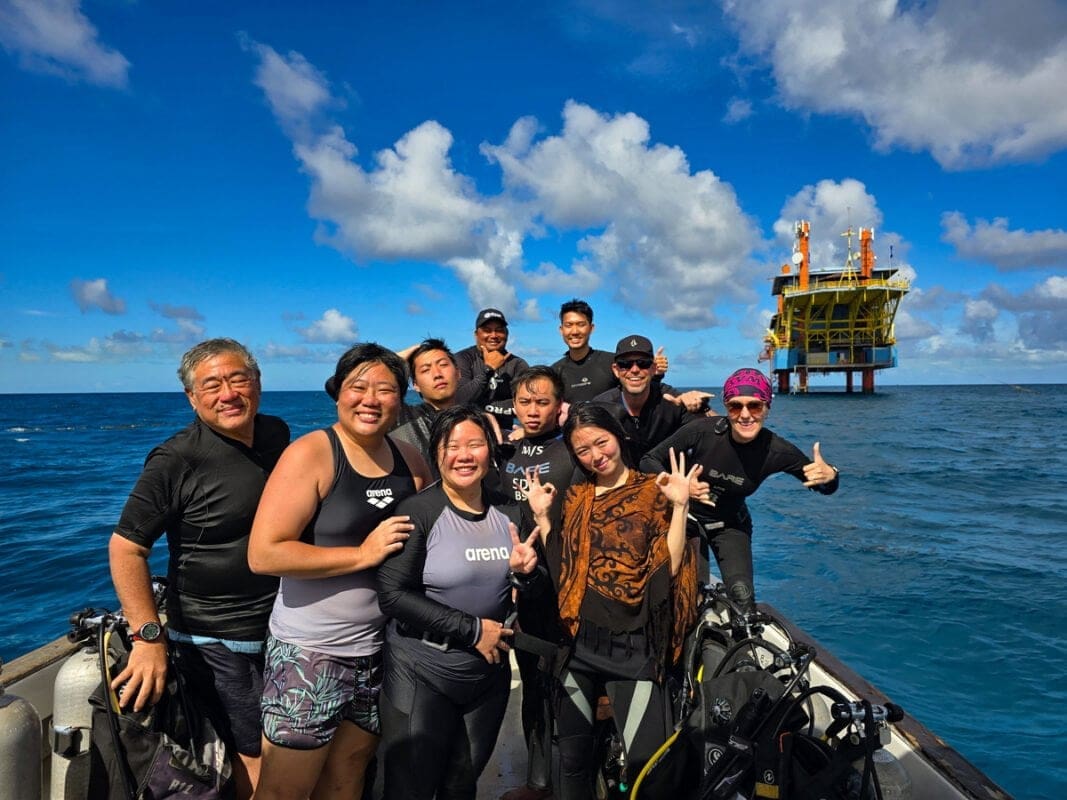
On a planet comprising 70% ocean, our travels would just be skimming the surface without scuba. Our open-water training has allowed us to swim alongside schools of blue tangs, go eye to eye with Nemos, watch a Mandarin fish mating dance, and explore inside shipwrecks. With a regulator in our mouths, we not only have the superpower to breathe underwater but also a reason to stop the chatter and listen to the rhythms of nature and our innermost thoughts. In the deep blue, there is nowhere to be but present.
Do YOU have the power of scuba? Getting dive-certified was truly one of the best things we’ve ever done for our travels and understanding of our blue planet. Start your PADI journey or up your certification (wreck-diving, coral conservation, dive master, etc.) by heading to PADI.com (use PADI discount code HONEYTREK15 to get 15% off any online course)…the world awaits!
Thanks for checking out our Top 10 Dive Destinations in the World (let us know which one is calling your name!) and a big thank you to PADI for sponsoring this post and for teaching us the art of scuba!!





Leave a Reply